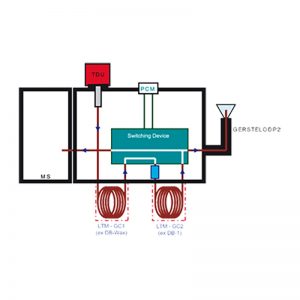A method for characterization of airborne particles including the nanoparticles fraction with a diameter of 29-58 nm in roadside atmosphere has been described. The method consists of thermal extraction (TE) and comprehensive two-dimensional gas chromatography (GC x GC) with novel detection capabilities, including high resolution time-of-flight mass spectrometry (HRTOF-MS), and simultaneous selective and mass spectrometric detection with a nitrogen phosphorous detector (NPD) and a quadrupole mass spectrometer (qMS). Increased selectivity with the GC x GC – HRTOF-MS allows a group type separation of a selected chemical class, e.g. oxygenated polycyclic aromatic hydrocarbons (oxy-PAHs), using mass chromatography with a 0.05 Da wide window in the complex sample matrix. Also, accurate mass detection provides candidate elemental compositions as well as NIST library search results for tentative identifi cations of 50 compounds. Moreover, the simultaneous selective and mass spectrometric detection with the NPD and the qMS elucidate the presence of 15 nitrogen containing compounds. Quantitative analysis of selected PAHs in several size-resolved particles was also performed by use of the TE – GC x GC – qMS with limited scan range. The method showed good linearity (r2 > 0.988) and high sensitivity (limit of quantifi cation: < 10 pg) for most of the target PAHs.
- Home
- About Us
- Products
- Automated Sample Preparation
- Advanced Analysis Technique
- Ion Chromatography
- Particle Size & Shape
- Zeta Potential Analyzer
- Surface Chemistry
- Spectroscopy
- Powder Characteristic
- Elemental Analyzer – Combustion
- Cleaning & Washing System
- Microwave Digestion System
- 3D Electronic Printing
- LabAlliance Instruments
- Services
- Application
- Contact Us
- Home
- About Us
- Products
- Automated Sample Preparation
- Advanced Analysis Technique
- Ion Chromatography
- Particle Size & Shape
- Zeta Potential Analyzer
- Surface Chemistry
- Spectroscopy
- Powder Characteristic
- Elemental Analyzer – Combustion
- Cleaning & Washing System
- Microwave Digestion System
- 3D Electronic Printing
- LabAlliance Instruments
- Services
- Application
- Contact Us
Characterization of Organic Compounds in Atmospheric Nanoparticles by Thermal Extraction – Comprehensive Two-Dimensional Gas Chromatography (GC x GC) in Combination with Selective Detection, Mass Spectrometry and Accurate Mass Detection
You are here:
- Home
- Lab Application
- Characterization of Organic Compounds in…





